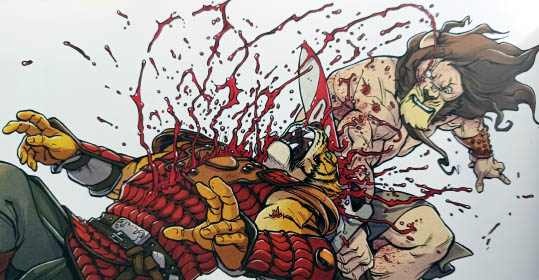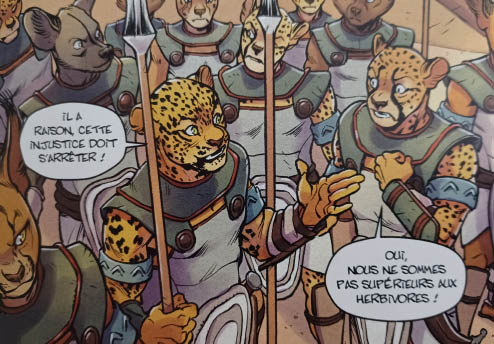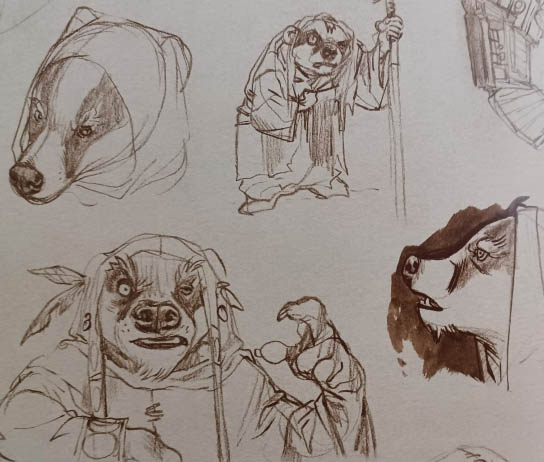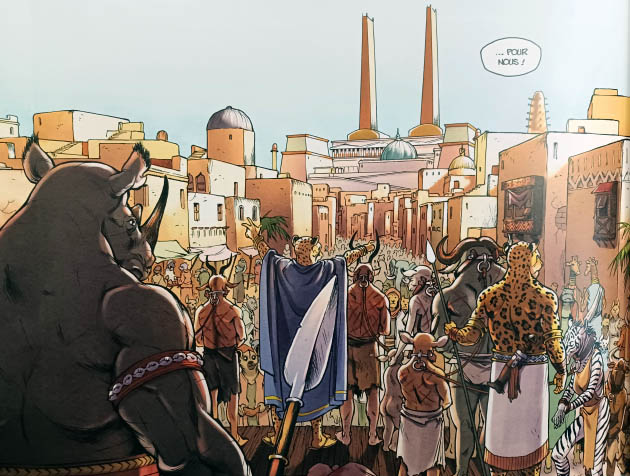Comic book review: "L'ogre Lion"
 L'ogre Lion is a three-volume French hardcover comic published from 2022 to 2024. The story and art are by Bruno Bessadi, with colouring by Joo, and it was published by Drakoo. Reading it with mid-level French, I had to look up a lot of words, and I doubt that it'll get an English translation, so... spoilers ahead!
L'ogre Lion is a three-volume French hardcover comic published from 2022 to 2024. The story and art are by Bruno Bessadi, with colouring by Joo, and it was published by Drakoo. Reading it with mid-level French, I had to look up a lot of words, and I doubt that it'll get an English translation, so... spoilers ahead!
This is an action-fantasy comic with lots of anthropomorphic mammals! The story begins in a medieval European setting. A badly-scarred lion stumbles through the woods, not native to this part of the world. (People keep mistaking him for a lynx.) He's afflicted in three ways: with amnesia, with a recurring nightmare of his dead children, and with an extremely angry, vengeful spirit inside of him.
Whenever the lion dies, he suddenly transforms into an 8-foot-tall antelope who slaughters any carnivores nearby, before the pain of manifesting in the mortal realm becomes too difficult to bear. The antelope then retreats into the spiritual realm, and restores the lion to life. Needless to say, the lion is not happy.
He soon acquires two allies. Wilt is a young goat who was seized by a cult, and would like to go home to his family. The other is a female rodent warrior named Othila, who joins them for the sake of bravery and adventure. And optionally to die a glorious death in battle; her people have a short life-span.

 Wilt manages to converse with the antelope spirit, who is named Bakham. The lion, meanwhile, is recognized and brought to King Charles, who identifies him as Kgosi, a de-throned ruler from the continent to the south. Charles has his own agenda, and Kgosi and friends make their escape with the aid of a vixen thief.
Wilt manages to converse with the antelope spirit, who is named Bakham. The lion, meanwhile, is recognized and brought to King Charles, who identifies him as Kgosi, a de-throned ruler from the continent to the south. Charles has his own agenda, and Kgosi and friends make their escape with the aid of a vixen thief.
The second volume establishes the backstory. Centuries ago in the south, Bakham was a respected, progressive ruler, who was killed and usurped by three lions, who established a reign of tyranny. Entire groups were exiled, became isolationist, or were made subservient. Slavery became rampant, and a cruel religion encouraged speciesism and a split between carnivores and herbivores.
In the time that the comic takes place, Kgosi is a descendant of the tyrannical lions, and just as nasty. Interrupting a magical ritual to summon Bakham's spirit, the antelope accidentally becomes bound to Kgosi's body. By the time Kgosi gets home, his traitorious brother Kagiso poisons his family, seizes the throne, and exiles him. Once Kgosi regains his memories later, he realizes just how awful a person he was - which is going to make it difficult for anyone to trust him. Luckily Wilt and Othila are able to convince people of his change of heart, as long as they can stop Bakham's manifestation from killing people first.
 The third and final volume is mainly about Kgosi and Kagiso gathering allies to do battle, then a lot of fighting. Kgosi defeats his brother, Bakham's spirit finds peace, and there's a happy ending.
The third and final volume is mainly about Kgosi and Kagiso gathering allies to do battle, then a lot of fighting. Kgosi defeats his brother, Bakham's spirit finds peace, and there's a happy ending.
The overall story is ok, though it feels mildly uneven. There's a good amount of world-building taking place, a couple of mild time jumps, and the third volume has some very convenient plot twists. My biggest problem is that a lot of the major characters are assholes. People in power are almost always shown to be mean, scheming, or corrupt. Thankfully not everyone! But until Kgosi gets his memories back, it's difficult to sympathise. Wilt and Othila have good hearts and are important to the story, but they feel more like sidekicks. (I never got used to Wilt's huge forehead and eyes.)
The tone of the story varies. Mostly it takes itself extremely seriously, especially in the third volume, and yet there are small moments of silliness. There's a lot of casual violence, like people's heads being bloodily sliced in half. Othila's preferred method of attack is to climb up her enemies and stab them in the eyes. And with so much of the third volume devoted to fighting, it didn't quite feel the same as the first two. Even with those complaints, I think Kgosi has a good story arc; it just takes a while to kick into gear.
 Let's talk visuals! They're excellent! Down-side, human feet, and no tails. Otherwise, lots of different mammals! Most are human-sized, while others are very small, like a bat messenger, or the rodent warriors. King Charles is fairly short, because he's a spaniel, of course. Still, some people's torsos look more like tinted skin than having fur. Don't expect pin-ups, regardless of the cover of volume two.
Let's talk visuals! They're excellent! Down-side, human feet, and no tails. Otherwise, lots of different mammals! Most are human-sized, while others are very small, like a bat messenger, or the rodent warriors. King Charles is fairly short, because he's a spaniel, of course. Still, some people's torsos look more like tinted skin than having fur. Don't expect pin-ups, regardless of the cover of volume two.
The colouring work was done by someone else, and it's a good match for the line-work; it really felt integrated. At the back of each volume are a couple pages of high-quality pencil sketches of various characters - no wonder each volume took a year to come out! And it's all in a realistic style, not cartoony. I quite liked the way forests and interiors were drawn as well. Once the story reaches the southern continent, there's an interesting mash-up of both Egyptian and African designs in buildings and dress.
All in all, I was very happy to have discovered this! For me personally, the art showing bloody deaths was a bit of a turn-off, and I wish the story flow could have been a little stronger, with more sympathetic characters. But if you want a high-quality anthropomorphic comic that you can show people - without necessarily being able to read it - there appears to be a printing that combines all three volumes under one cover (ISBN 9782382332252).





Comments
Fred Patten would have gone nuclear for this, I think...
The artwork looks nice, but from what they have here it looks like they give in to the temptation to "humanize" the female character's faces more than the males -- cuz otherwise, how could you tell they're female? Of course.
Weirdly, it varies. The lionesses have short muzzles but their noses aren't as animal as their male counterparts (like you observed with the cheetah on the cover of volume two). But there isn't a high female presence. There's one panel with a pig-woman, who unfortunately has the pig-nose-without-a-lower-chin syndrome. However, the vixen thief character, she's got a muzzle. And if someone is based on a ruminant (like Wilt's mother), they've all got muzzles as well.
This seems to happen quite often in francobelgian anthropomorphic comics - Blacksad is another example.
At the current time, it seems that France/Belgium are delivering more furry comics (at least in print or in a non-newspaper strip format) than the fandom itself. "Les 5 Terres" would be another example (12 volumes and 2 more announced). "Solo" only made it to two US releases AFAIK whereas it is a full series with spinoffs in the French version. "Le Château des Animaux" has a US translation at least under the title "Animal Castle". "Le Bois des Vierges" or the "Tracnar & Faribol" volumes don't even have a German translation. "Jim Hawkins" and "Atlas & Axis" didn't make it to the US (unless I missed something). "De cape et de Crocs" was finally finished in Germany. "Canardo" ended after the author died - I'm pretty sure some volumes were published in English. And the list goes on.
Is the "no tails" thing also part of this?
That seems to be a non-American thing in general, or am I mistaken?
Perhaps the deletion of tails has to do with the fact that we're nothing but mammals
It seems totally random, sometimes even in a single book. In "Blacksad", some characters do have tails, even clearly pronounced ones, but the mains do not. In "Tracnar & Faribol" and "Le Bois des Vierges", the furry characters do have tails. Not so in "Les 5 Terres". "Jim Hawkins" again shows some characters with tails but not consistently all, it varies even between closely related species. The books featuring ferals obviously need tails, but as soon as it comes to anthros, all bets are off.
On the other paw, "Usagi Yojimbo" shows tailless characters too, whereas e.g. "Lackadaisy" features tails.
I don't know why an artist chooses tailless anthros. I get it if it's animated media; tails need a lot of work to get right, but when drawn, they are fairly simple to do. However, you need to do some worldbuilding (as for chairs, saddles, clothing...) to integrate tails properly.
At the very least, I'd say it's a "tell" what you're reading/watching wasn't made by a member of the furry fandom.
I guess the only American non-tailed funny animal I can think of is Goofy, and of course we're still debating if he even is a funny animal or something else entirely.
Yes, I suppose within the fandom, tails are the preferred style and most common. (Despite Usagi (tailless) starting out in the fandom.) Whereas outside of the fandom, artists don't always care as much.
The old German funny animal creations, Fix and Foxi, do have tails although predating the fandom. The funny animal with the longest tail is still the Marsupilami (being an actual animal, it would look strange without). Worgen are tailless. All in all, there is no rule - maybe someone will write their doctorate about the topic. (And head fur / hair, and fur in general.)
Post new comment